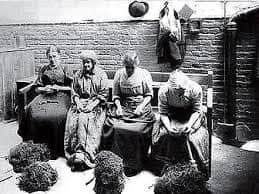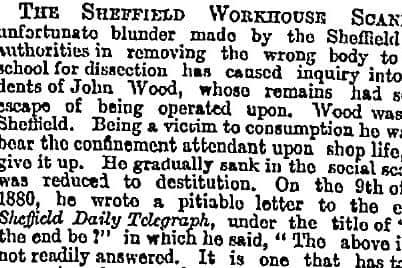Have you heard of the Sheffield Workhouse scandal - where the body of the wrong man was sent to the medical school to be dissected by students?
and live on Freeview channel 276
John Woods, who was in his mid-30s at the time of his death, had written to the Sheffield Telegraph two years earlier, complaining of his financial woes after developing consumption and becoming too ill to work.
The family had quickly descended into poverty and were staying in lodgings in Alderson Road, run by widower Frances Mason.


Advertisement
Hide AdAdvertisement
Hide AdIn his letter, entitled “What will the end be?” John stated: “The above is a question not readily answered. It is one that has taken serious possession of my mind of late; and as I ponder over it a sadness comes over me, my blood curdles and I tremble when I think of it, because I fear I can foresee my own end, which will most assuredly be for want of food, unless a change soon takes place.”
The editor of the paper was so moved by John’s plight and that of his 28-year-old wife Eliza and their four daughters that he took action - securing the family some small financial aid and around this time the Woods family appeared to move to new lodgings on West Street.
But his health continued to decline and by 1882 the end was near and, fearing the impact of a death in the house, his new landlady insisted he be transported to the workhouse, where he died within minutes of being put to bed.
A report dated January 31, 1882, in the Sheffield Telegraph states: “Then by mistake his body was taken to the medical school for dissection, and the mistake would not have been detected had not the widow desired a last look at her husband’s face.”


Advertisement
Hide AdAdvertisement
Hide AdFor instead of seeing John’s familiar face when the coffin lid was opened, Eliza instead gazed down at that of a 71-year-old pauper.
A messenger was then urgently dispatched to the medical school and stopped the dissection in the nick of time - the students only getting as far as shaving John’s face and head.
The case caused a massive scandal and an inquiry was called - one paper even accused the authorities of body-snatching.
Under legislation at the time, workhouse governors were only allowed to check dispatch bodies for dissection if all reasonable steps had been taken to ensure there was no next of kin.
Advertisement
Hide AdAdvertisement
Hide AdThe disposal of the bodies of the poor in such a way had never been popular with the public and seems to have come about after the Anatomy Act of 1832 prohibited the dissection of hanged murderers but instead allowed the most impoverished to be used to aid in medical training - the act effectively also ended the practice of body snatching.
The subsequent hearing revealed that a new employee had not placed tags around the various bodies stored in the ‘dead house’ and the wrong corpse had been dispatched for dissection.